If you are seeking a reliable indoor Bonsai tree species, the jade Bonsai tree may be your perfect match. Native to South Africa, the jade Bonsai tree may refer to two different types of plants, but both have very similar care needs and grow well inside your own home. Whether you’re a beginning Bonsai tree artist or a pro looking for something new, jade Bonsai trees are a fun and unique Bonsai tree specimen to cultivate.
Both the dwarf jade Bonsai tree and the classic jade Bonsai tree are discussed here. With their similar appearance and needs, these two succulent plants make interesting Bonsai trees. Here’s how to care for one, including how to propagate and style it.
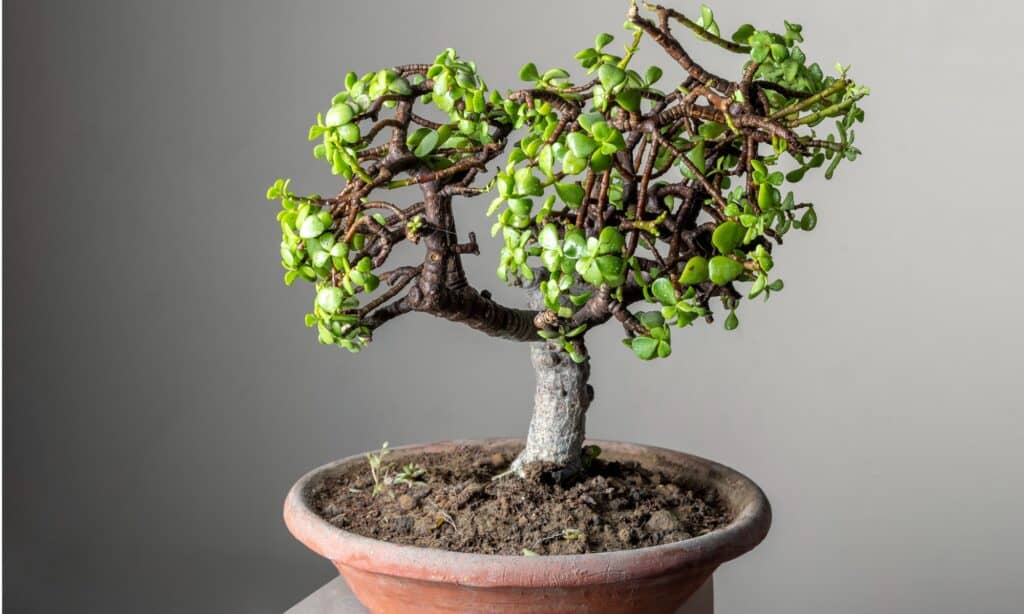
Native to South Africa, the jade Bonsai tree may refer to two different types of plants, but both have very similar care needs and grow well inside your own home.
©iStock.com/prabhjits
| Jade Bonsai Tree Facts | |
|---|---|
| Botanical Name | Portulacaria afra, Crassula ovata |
| Common Names or Types | Elephant bush, dwarf jade, jade plant, money tree (not to be confused with Pachira aquatica!) |
| Sunlight | Full sunshine, at least 6-8 hours daily |
| Soil | Well-draining mix of succulent and Bonsai tree soil blends. Do not water after repotting; roots need to harden off and heal! |
| Water | Forgiving compared to other Bonsai tree species. Allow soil to dry out and minimize watering in the wintertime. |
| For Beginners? | Yes! Very forgiving and fun to shape |
| Indoors or Outdoors? | Primarily indoors unless grown outside in Zones 8-10. Would benefit from outdoor exposure in summertime |
| Pairs Well With… | Other succulents, rock formations, and fun additions to your Bonsai tree container (figures, trinkets, etc) |
Common Types of Jade Bonsai Trees
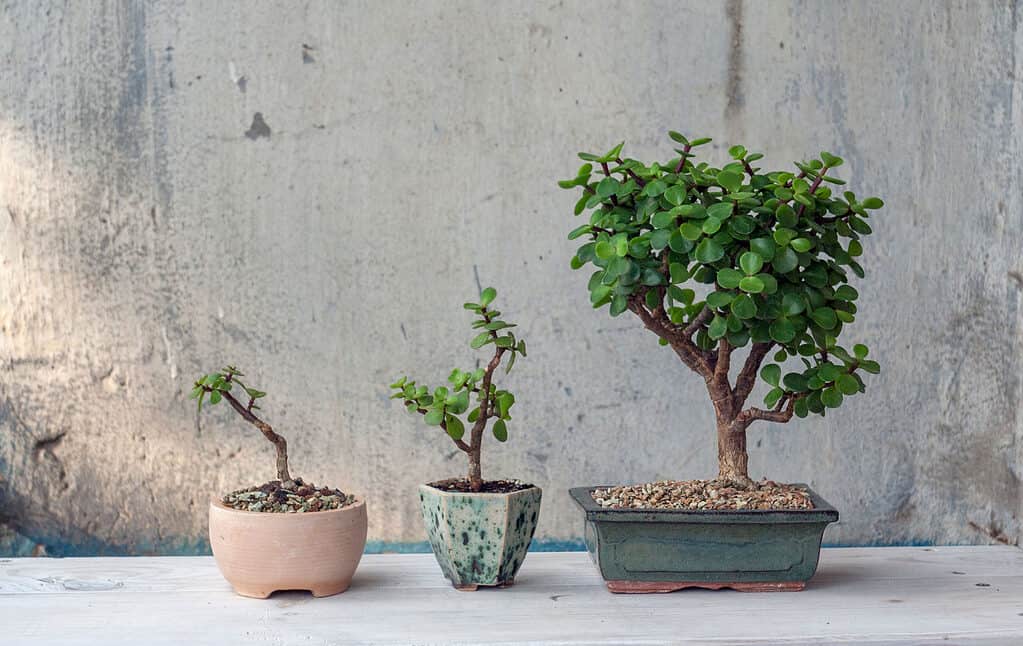
There are still some subtle differences between the two different types of jade Bonsai trees, especially when you consider the fact that they belong to different species.
©pjatnica/Shutterstock.com
Unlike many other types of Bonsai trees, there are only two common types of jade Bonsai tree species. They are specific and easily cultivated into Bonsai trees, but you won’t have countless cultivars and varieties to choose from. If you are looking for plenty of options, you may want to check out traditional trees such as maples or pines. These offer a variety of shapes, styles, and foliage types.
There are still some subtle differences between the two different types of jade Bonsai trees, especially when you consider the fact that they belong to different species. Let’s take a closer look at their differences now.
Jade Bonsai Tree vs Dwarf Jade Bonsai Tree
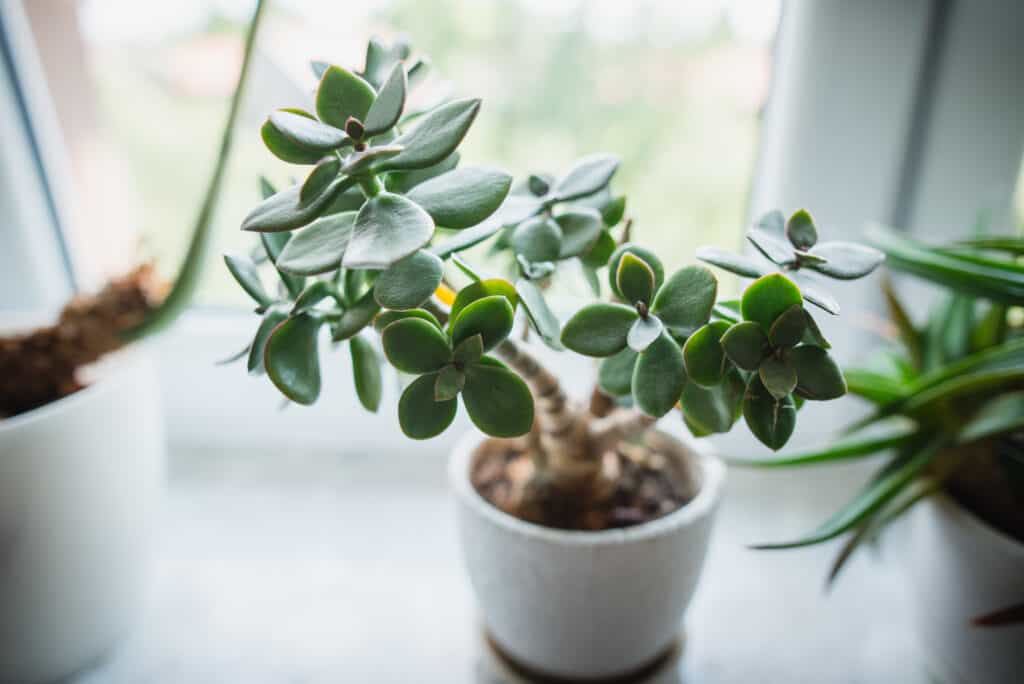
Given the leaf size and shape found on Jade plants, many people prefer the dwarf jade over the standard jade plant. Its leaf size better supports Bonsai tree shaping and development.
©Jus_Ol/Shutterstock.com
Distinguishing your jade Bonsai tree can be difficult when you consider the fact that they are named similarly and are strikingly similar in their appearances. When it comes to popular jade Bonsai tree options, the dwarf jade Bonsai tree is often utilized more than a standard jade plant. This is because dwarf jade plants produce smaller leaves, making them better suited for Bonsai tree shaping.
Also known as an elephant bush, dwarf jade plants are classified as Portulacaria afra. The succulent plants simply known as jade plants are botanically classified as Crassula ovata. Leading to even more confusion, jade plants are commonly referred to as money trees. However, the money tree used in Bonsai tree cultivation can be classified as Pachira aquatica; this is also a very common housewarming gift and houseplant for luck.
Both jade plants and dwarf jade plants can be used in Bonsai tree cultivation. However, given the leaf size and shape found on jade plants, many people prefer the dwarf jade over the standard jade plant. Its leaf size better supports Bonsai tree shaping and development, the standard jade plant still makes a lovely Bonsai tree specimen when properly pruned!
Caring for Your Jade Bonsai Tree
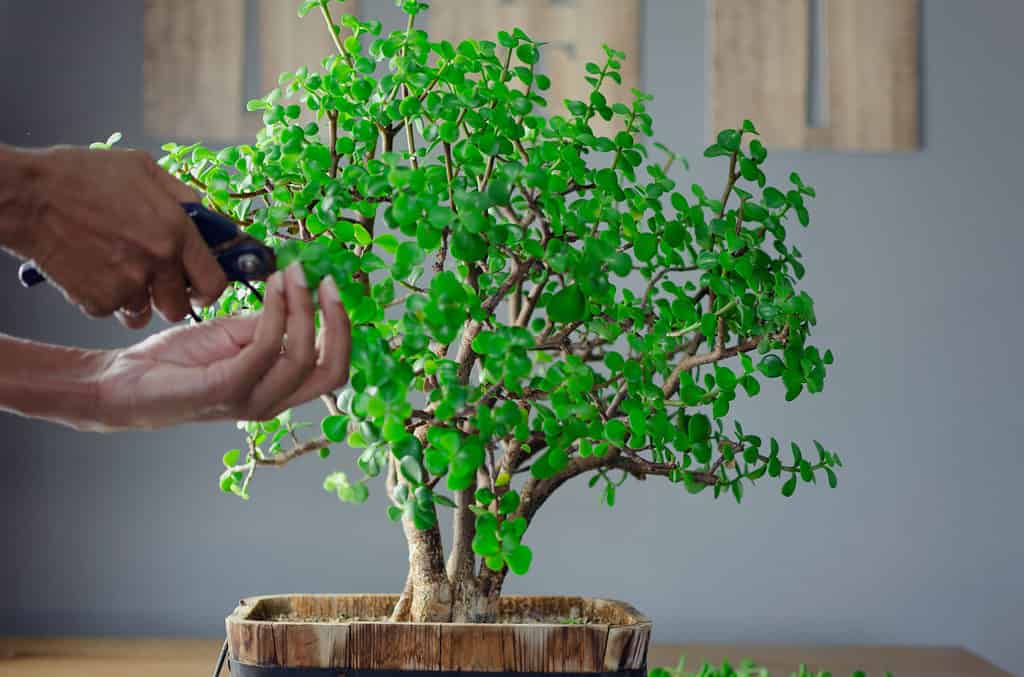
Jade Bonsai trees require high levels of sunlight; you know your dwarf jade Bonsai tree is getting enough sunshine if its leaves gain a reddish hue.
©Mlle Sonyah/Shutterstock.com
Now that you understand the differences between a standard jade Bonsai tree and a dwarf Jade Bonsai tree, how might you begin to care for one? These plants have succulent leaves and fleshy branches or trunks, making them different from a variety of types of Bonsai trees. However, they can still be shaped and created into a landscape that is appealing to look at, especially when you consider the fact that most jade Bonsai trees grow best indoors!
Let’s talk about the care requirements for these trees now.
Sunlight
Whether artificial or natural, jade Bonsai trees require high levels of sunlight. You should plan on placing your jade plant in a location that receives at least six to eight hours of direct sunlight each and every day. You can manufacture this inside, but jade plants prefer natural, direct sunshine in the warmer months of the year. In fact, dwarf jade plants will produce foliage with a pink or red tinge when receiving enough sunlight!

One of the main reasons why jade Bonsai trees are ideal for beginners is the fact that they’re watering routine isn’t as demanding as other Bonsai trees.
©Gilbert Cantu/Shutterstock.com
Soil Type
The good news is, jade Bonsai trees have succulent leaves and thrive in either Bonsai tree soil mixes or succulent soil mixes. It’s recommended to make your own soil type for your jade Bonsai tree so that it is well-draining and full of the proper nutrients the plant needs. Incorporating clay or rocks into your soil mixture is a good idea, but most jade plants aren’t very fussy about their soil.
Water
One of the main reasons why jade Bonsai trees are ideal for beginners is the fact that they’re watering routine isn’t as demanding as other Bonsai trees. Jade plants store plenty of water in their leaves and stems, giving them more hardiness during periods of drought or forgotten waterings. However, allowing your jade plant to dry out a little in between waterings is a good idea, but not too much. In the wintertime especially, you can likely forget to water your jade plant more than you originally anticipated!
Speaking of watering, it’s important to let your brand-new jade Bonsai tree dry out and establish its roots in dry soil before you water it the first time after repotting. The absorbent nature of jade plant roots can cause rot or other diseases if overwatered too early, so make sure this succulent has time to relax before its first watering.
Placement
As already mentioned, placing your jade Bonsai tree in a location that receives plenty of sunlight is a good place to start. Whether this is a south-facing window within your own home, or on a sunny outdoor patio, sunshine is key for this Bonsai tree to thrive. Keep in mind that temperatures below 40 degrees Fahrenheit will start to harm your jade plant, so indoor growing may be necessary for the winter depending on your location.
Pruning Your Jade Bonsai Tree

The branches of the jade Bonsai tree are soft, heavy, and delicate, typically bending and drooping on their own.
©Olena Antonenko/Shutterstock.com
Knowing that your jade Bonsai tree is a succulent plant is a good place to start when you consider pruning or shaping it. The fast-growth habit of this tree lends well to consistent pruning, particularly during the spring and summertime. However, the branches of the jade Bonsai tree are soft, heavy, and delicate, typically bending and drooping on their own. Using wire to shape them can cut into the flesh of their branches and harm them, so only do this with caution.
Many Bonsai tree experts recommend leaving your jade Bonsai tree to its own devices, at least in terms of its overall shape. Either that or you need to closely monitor your jade Bonsai tree while it is wired. Any damage to its fleshy trunks or branches will likely result in rotting and poor health for your tree. However, pruning is highly promoted, as doing so may even encourage growth along the lower levels of your jade Bonsai tree trunk!
Recommended Jade Bonsai Tree Styles
While shaping with wires can be tricky with either type of jade Bonsai tree, you can form this particular plant into a number of Bonsai tree styles. Many people choose a double or multi-trunk to design, something that is easy to achieve with proper pruning. A slanting or informal upright style may also suit the jade Bonsai tree well.
Propagating Your Jade Bonsai Tree
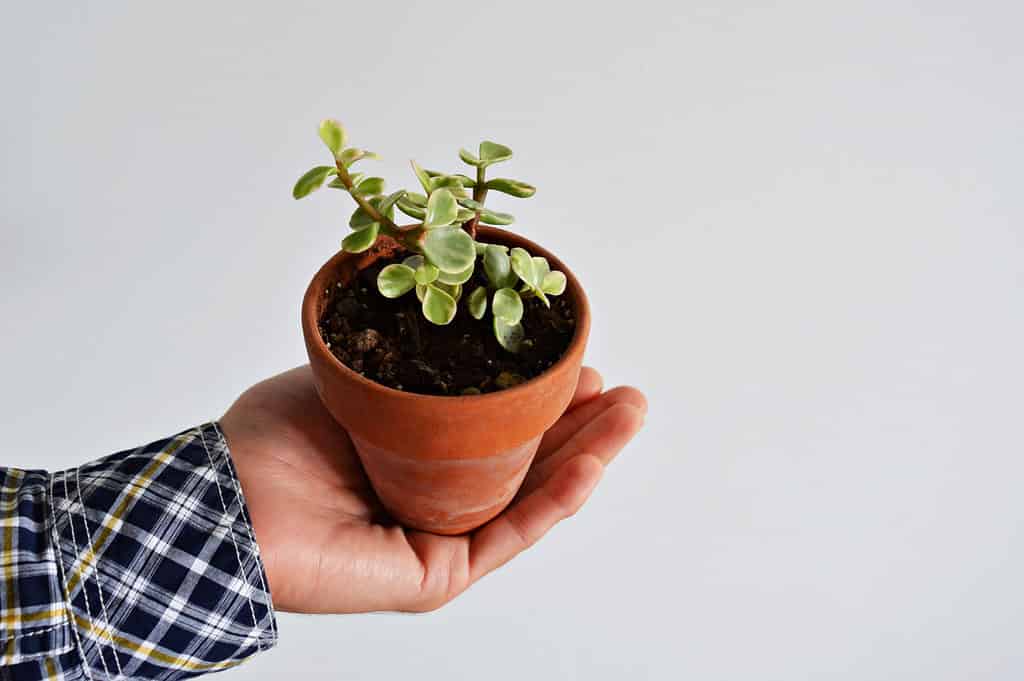
The fast growth habit of the average jade plant makes it easy to grow into a fully formed Bonsai tree in only a couple of years!
©Maryana Volkova/Shutterstock.com
Like most other succulent species, jade Bonsai trees are extremely easy to propagate from cuttings. This is the recommended method over growing a jade Bonsai tree from seed, as this process takes significantly longer than simply taking a cutting from an existing plant. You may already know someone that is growing a jade plant, making it easy to remove a piece smaller than 3 inches.
After taking a sanitized cutting, you should allow your jade plant to dry out and form a callous over where it was cut. This helps in the overall growth and development of your plant, preventing diseases or other harmful pests from invading it while it heals. Finally, the fast growth habit of the average jade plant makes it easy to grow into a fully formed Bonsai tree in only a couple of years!
Common Problems with Jade Bonsai Trees
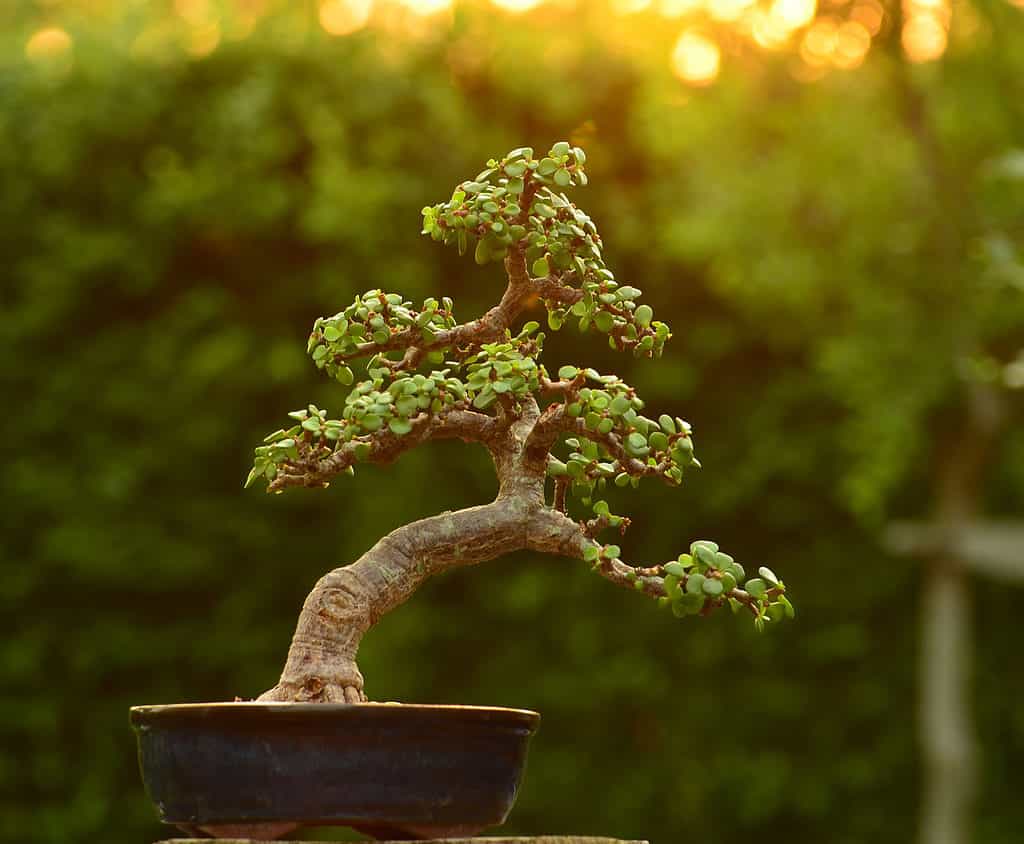
Whether you choose a jade or a dwarf jade plant for your Bonsai tree cultivation, these succulent trees are unique and forgiving.
©Gilbert Cantu/Shutterstock.com
When receiving adequate sunlight, you’re unlikely to have very many problems with your jade Bonsai tree, whether you grow it indoors or out. It doesn’t attract pests or fungal infections unless it is being overwatered. Root rot is a possible killer of your jade Bonsai tree, but this is easily avoided with careful watering habits.
This is good news for beginners who are wary about killing Bonsai trees. A jade Bonsai tree is unlikely to be fussy or difficult in terms of its standard care. However, pay special attention to the seasons that you prune and shape this particular plant. Winter is a time of dormancy for most plant species, including the jade plant. Make sure that you avoid repotting, pruning, and shaping during this time of year for the overall health of your tree.
Whether you choose a jade or a dwarf jade plant for your Bonsai tree cultivation, these succulent trees are unique and forgiving. If you’ve been waiting for a sign to start a Bonsai tree, the jade plant might just be it!
The photo featured at the top of this post is © Gilbert Cantu/Shutterstock.com
Thank you for reading! Have some feedback for us? Contact the AZ Animals editorial team.






